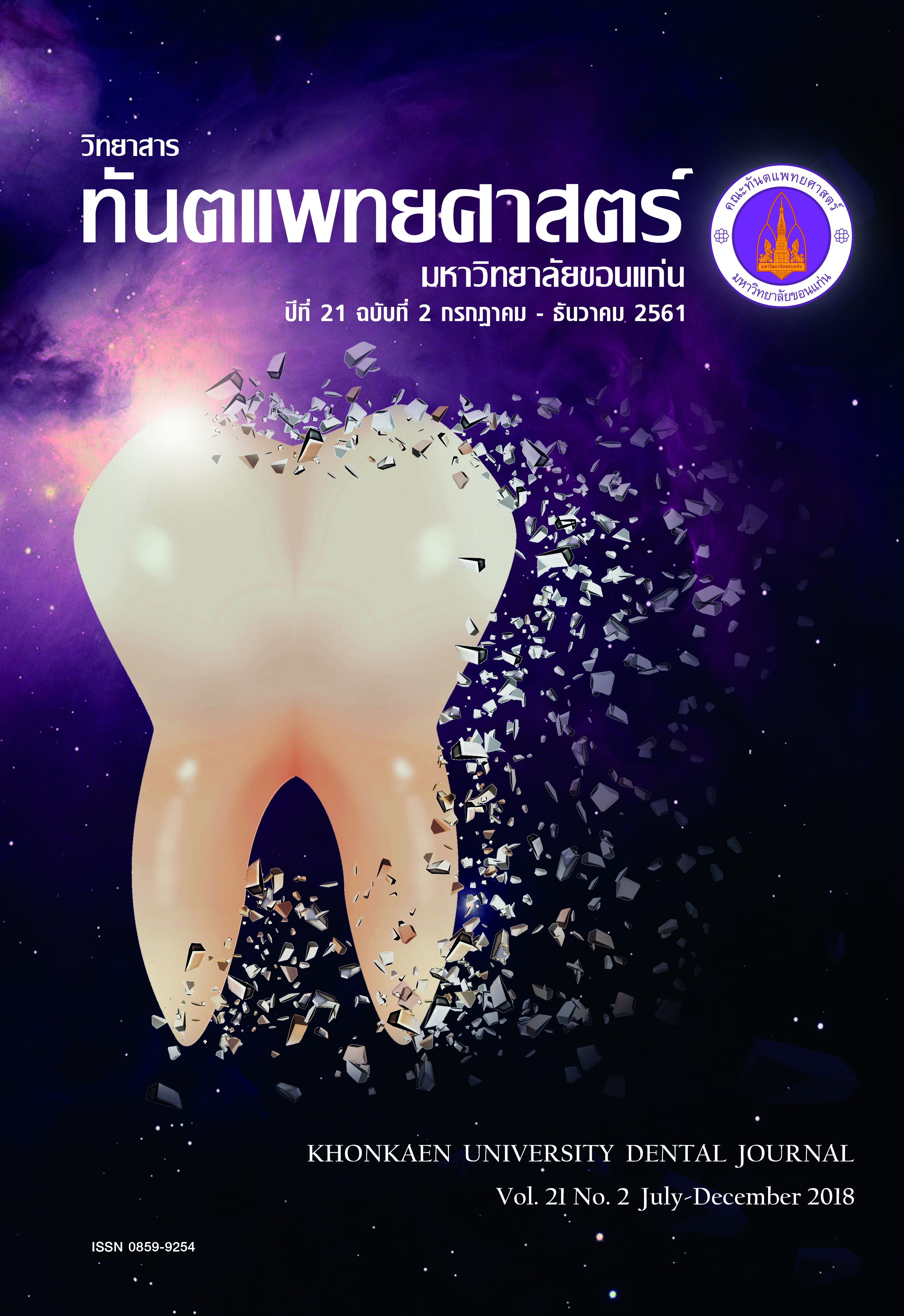Effect of Fluoride Varnish for Preventing Dental Erosion in Children
Main Article Content
Abstract
Dental erosion is a worldwide oral health problem. The incidence tendency is rising due to the consumption of acidic foods and soft drinks. Dental erosion is the cause of dentin hypersensitivity, leading to eating difficulties and consequently affects the quality of life. Nowadays, studies are conducted to find the strategies for dental erosion prevention. Fluoride varnish is a topical fluoride used by professional dental practitioners for preventing dental caries. This material is also capable of efficiently preventing dental erosion and reducing hypersensitivity. This literature review focuses on the mechanisms of dental erosion prevention by various types of fluorides, as well as the effectiveness of fluoride varnishes on the prevention of dental erosion. In vitro studies indicated that fluoride varnishes could prevent the initial stage of dental erosion. However, the lack of clinical evidence for supporting the dental erosion prevention capability of fluoride varnishes are still lacking and need further investigations.
Article Details
บทความ ข้อมูล เนื้อหา รูปภาพ ฯลฯ ที่ได้รับการลงตีพิมพ์ในวิทยาสารทันตแพทยศาสตร์ มหาวิทยาลัยขอนแก่นถือเป็นลิขสิทธิ์เฉพาะของคณะทันตแพทยศาสตร์ มหาวิทยาลัยขอนแก่น หากบุคคลหรือหน่วยงานใดต้องการนำทั้งหมดหรือส่วนหนึ่งส่วนใดไปเผยแพร่ต่อหรือเพื่อกระทำการใด ๆ จะต้องได้รับอนุญาตเป็นลายลักษณ์อักษร จากคณะทันตแพทยศาสตร์ มหาวิทยาลัยขอนแก่นก่อนเท่านั้น
References
2. Habib M, Hottel TL, Hong L. Prevalence and risk factors of dental erosion in American children. J Clin Pediatr Dent 2013;38(2):143-8.
3. Chadwick BL, White DA, Morris AJ, Evans D, Pitts NB. Non-carious tooth conditions in children in the UK, 2003. Br Dent J 2006;200(7):379-84.
4. Kazoullis S, Seow WK, Holcombe T, Newman B, Ford D. Common dental conditions associated with dental erosion in schoolchildren in Australia. Pediatr Dent 2007;29(1):33-9.
5. Auad SM, Waterhouse PJ, Nunn JH, Steen N, Moynihan PJ. Dental erosion amongst 13- and 14-year-old Brazilian schoolchildren. Int Dent J 2007;57(3):161-7.
6. Caglar E, Kargul B, Tanboga I, Lussi A. Dental erosion among children in an Istanbul public school. J Dent Child (Chic) 2005;72(1):5-9.
7. Linnett V, Seow WK. Dental erosion in children: a literature review. Pediatr Dent 2001;23(1):37-43.
8. Okunseri C, Okunseri E, Gonzalez C, Visotcky A, Szabo A. Erosive tooth wear and consumption of beverages among children in the United States. Caries Res 2011;45(2):130-5.
9. Lussi A, Schaffner M, Jaeggi T. Dental erosion - diagnosis and prevention in children and adults*. Int Dent J 2007;57 (S6):385-98.
10. Imfeld T. Prevention of progression of dental erosion by professional and individual prophylactic measures. Eur J Oral Sci 1996;104(2 ( Pt 2)):215-20.
11. Gandara BK, Truelove EL. Diagnosis and management of dental erosion. J Contemp Dent Pract 1999;1(1):16-23.
12. Magalhaes AC, Wiegand A, Rios D, Buzalaf MA, Lussi A. Fluoride in dental erosion. Monogr Oral Sci 2011;22:158-70.
13. Sar Sancakli H, Austin RS, Al-Saqabi F, Moazzez R, Bartlett D. The influence of varnish and high fluoride on erosion and abrasion in a laboratory investigation. Aust Dent J 2015;60 (1):38-42.
14. Alexandria AK, Valenca AMG, Cabral LM, Maia LC. Fluoride varnishes against dental erosion caused by soft drink combined with pediatric liquid medicine. Braz Dent J 2017; 28(4):482-88.
15. Alexandria AK, Vieira TI, Pithon MM, da Silva Fidalgo TK, Fonseca-Goncalves A, Valenca AM, et al. In vitro enamel erosion and abrasion-inhibiting effect of different fluoride varnishes. Arch Oral Biol 2017;77:39-43.
16. Imfeld T. Dental erosion. Definition, classification and links. Eur J Oral Sci 1996;104(2 ( Pt 2)):151-5.
17. Taji S, Seow WK. A literature review of dental erosion in children. Aust Dent J 2010;55(4):358-67; 358-67
18. Wiegand A, Attin T. Influence of fluoride on the prevention of erosive lesions--a review. Oral Health Prev Dent 2003;1 (4):245-53.
19. Ganss C, Lussi A, Schlueter N. The histological features and physical properties of eroded dental hard tissues. Monogr Oral Sci 2014;25:99-107.
20. Lussi A, Carvalho TS. The future of fluorides and other protective agents in erosion prevention. Caries Res 2015;49 (Suppl 1):18-29.
21. Attin T, Koidl U, Buchalla W, Schaller HG, Kielbassa AM, Hellwig E. Correlation of microhardness and wear in differently eroded bovine dental enamel. Arch Oral Biol 1997;42(3):243-50.
22. Kaidonis JA, Anastassiadis PM, Lekkas D, Ranjitkar S, Amaechi BT, Townsend GC. Prevention and control of dental erosion: professional clinic care. In: Amaechi BT, editor. Dental erosion and its clinical management. Cham: Springer 2015. p. 151-68.
23. Walczak M, Turska-Szybkab A. The efficacy of fluoride varnish containing different calcium phosphate compounds. Fluoride 2017;50(1pt2):151-60.
24. Data sheet Ename Prol Updated 17 November 2015 [Internet]. 2015 [cited 26 May 2018]. Available from: https://www.premusa.com/wp-content/uploads/2015/07/ SDS_EnProVarn_Eng_R8.pdf.
25. Data sheet MI varnish Updated 9 July 2014 [Internet]. 2014 [cited 26 May 2018]. Available from: https://sourceo nedental.com/spree/documents/products/14835/original/ MIVarnish_SDS.pdf?1426577847.
26. Data sheet Clinpro White varnish Updated 27 May 2015 [Internet]. 2015 [cited 26 May 2018]. Available from: https://www.henryschein.ca/MSDS/105Y349.pdf.
27. Data sheet Embrace Updated 1 May 2017 [Internet]. 2017 [cited 26 May 2018]. Available from: https://docs.google. com/viewerng/viewer?url=https://www.pulpdent.com/ wp-content/uploads/2015/03/GHS-SDS-Embrace- Varnish-1.pdf&hl=en_US.
28. Huysmans MC, Young A, Ganss C. The role of fluoride in erosion therapy. Monogr Oral Sci 2014;25:230-43.
29. Saxegaard E, Rolla G. Fluoride acquisition on and in human enamel during topical application in vitro. Scand J Dent Res 1988;96(6):523-35.


